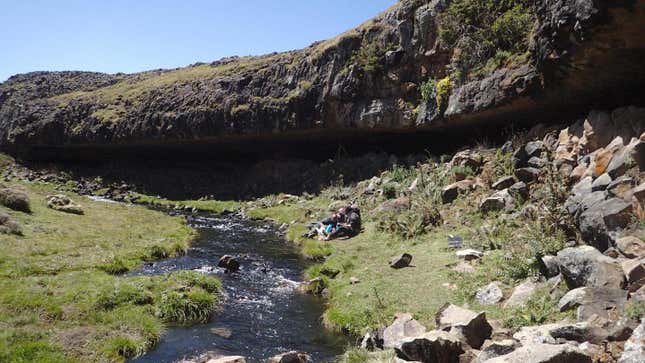
Archaeologists working in the Bale Mountains of Ethiopia have uncovered the earliest evidence to date of human habitation in a high-altitude environment. Living over 11,000 feet above sea level, these early mountaineers ate rodents to survive the harsh ice age conditions.
New research published this week in Science describes the oldest known human occupancy of a high-altitude environment. Between 47,000 and 31,000 years ago, Stone Age foragers occupied a rock shelter in the Bale Mountains of Ethiopia, which is 11,381 feet (3,469 meters) above sea level. The authors of the new study, led by researchers from Martin Luther University, aren’t sure if the shelter was used intermittently or if the occupation was permanent.
Indeed, it seems incredible that anyone, least of which foragers from the Middle Paleolithic period, would want to make this seemingly inhospitable place their home. At these high altitudes, humans are subject to hypoxia—a condition in which the body doesn’t receive enough oxygen. Hypoxia can result in dizziness, shortness of breath, organ failure, and sometimes death. Mountains also tend to feature weather extremes, such as wild temperature fluctuations and copious amounts of rain. Resources, such as food, also tend to be scarce in high-altitude regions.

Despite these hardships, early humans dared to make mountains their home. Other examples in the archaeological literature include occupations of the Tibetan Plateau (around 3,600 years ago based on archaeological evidence) and the Andean Highlands of Peru (between 6,800 and 1,400 years ago), but the occupation at the Fincha Habera rock shelter in southern Ethiopia is now considered the oldest example of high-altitude living (importantly, this involves habitation of some sort, and not just ventures up to the mountains to collect resources).
In order for these Paleolithic humans to resettle and spend some time in the harsh Bale Mountains, there had to be the associated pushes and pulls.
In terms of the push, the foragers were having to contend with challenging ice age conditions. As the new research points out, the valleys nearby were drying out, forcing the Stone Age humans to find new places to live.

In terms of the pull, the Bale Mountains, perhaps surprisingly, had quite a lot to offer. Excavations done over three years at the Fincha Habera rock shelter revealed troves of artifacts, including stone tools—some made from obsidian—several pottery shards, and a single glass bead. The archaeologists also found burnt animal bones and the hearths of former fires. Radiocarbon dating of these items placed habitation at the site from between 47,000 and 31,000 years ago.
The sheer quantity of mole-rat remains found at the site suggests the humans’ diet primarily consisted of these rodents. Mole-rats were abundant, easy to hunt, and contained sufficient amounts of protein for survival, according to the new research.

The researchers, led by MLU’s Bruno Glaser, used innovative techniques to identify ancient weather patterns and to analyze soil samples found in and around the site. During the ice age, this region of the Bale Mountains was located just beyond the southernmost encroachment of the nearest glaciers. Due to fluctuating weather patterns and phases of glacial melting, the people who lived in the area likely had easy access to fresh water.
Finally, nearby volcanic deposits of obsidian represented another appealing reason to stay in the region. These rocks can get incredibly sharp when they’re knapped, making them a prized resource of the Stone Age.
“The settlement was therefore not only comparatively habitable, but also practical,” said Glaser in a press release.
The researchers say prolonged occupation at the Fincha Habera rock shelter is a distinct possibility, but they don’t have enough evidence to prove it. Writing in a related Science Perspective, anthropologist Mark Aldenderfer from the University of California, commended the authors for not speculating beyond the available evidence:
In the new work, Ossendorf et al. carefully describe both the features of the Fincha Habera rock shelter and the range of artifacts recovered at the site. In their conclusions, the authors defined Fincha Habera as a “residential base” but say little about the duration or season of occupation of the site. Their restraint is admirable because it would have been tempting to speculate whether the site was occupied permanently. They mention this possibility but are aware that their data cannot support the claim. They also note that the site could have been part of a settlement system involving the very near lowlands.
Interestingly, the researchers also found evidence of occupation at the rock shelter starting around 10,000 years ago. During this second phase of occupation, its inhabitants increasingly used the site as a hearth, and evidence taken from the soil in the form of animal excrement meant grazing animals had finally ventured to the region.
It seems the later inhabitants had graduated from mole-rats—no doubt a significant improvement in their quality of life.